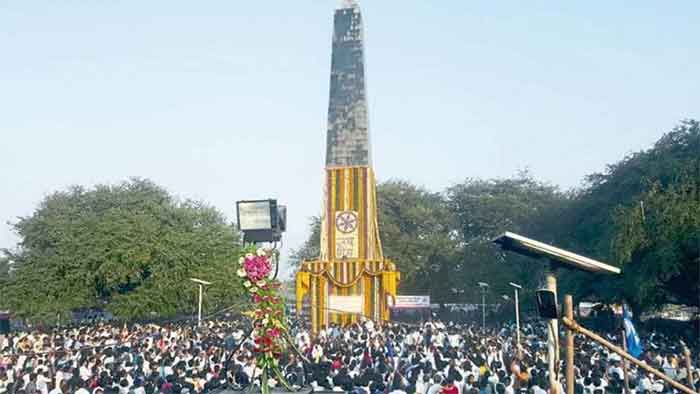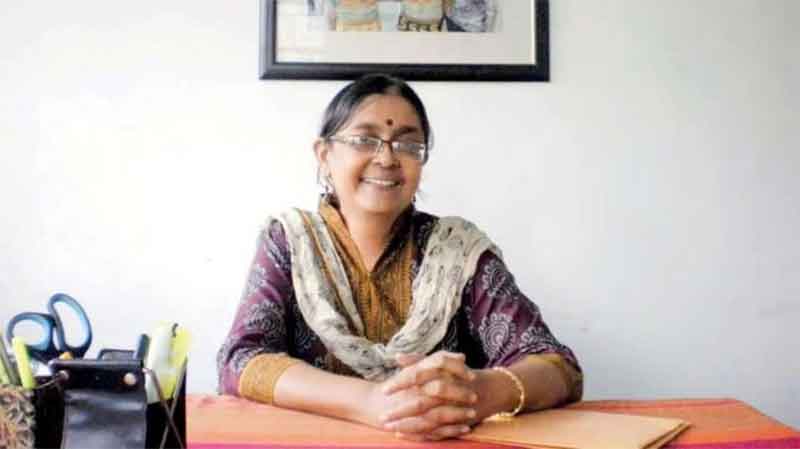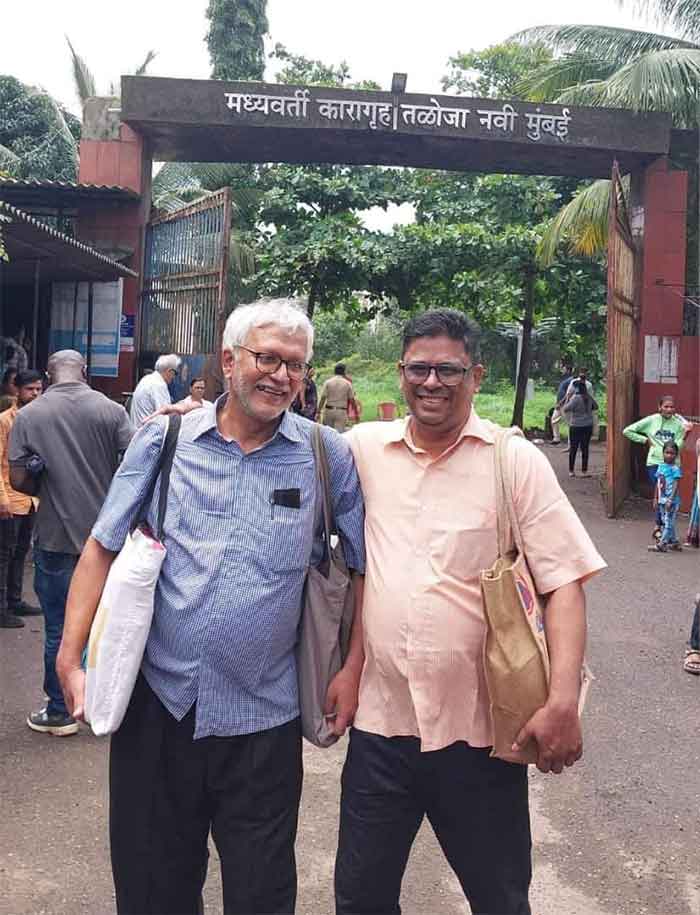
The Bhima Koregaon battle took place on 1 January 1818 between a contingent of the East India Company army mainly consisting of soldiers belonging to the Mahar caste (one of the many “untouchable” castes in India whose members are today known as Dalits) and the army of the Peshwas, who were the rulers of the Maratha confederacy.
The Peshwa army consisted of 28000 soldiers, while the East India Company force was only 800 strong. The Company army fought valiantly and held its ground for over 12 hours. Eventually, it managed to drive away the Peshwas, who had been advancing towards the Company-held city of Pune with the intention of launching an attack.
This victory over the Peshwas was very significant for the British. It helped them cement their rule in western India and could be seen as a pivotal moment in their conquest of the subcontinent. The East India Company built a pillar at the site of the battle to commemorate the brave soldiers who dared to take on the formidable Peshwa army and successfully held their own against them.
The event is a matter of great pride for many communities to this day. Every year, lakhs of people travel to the site of the pillar to celebrate the battle. Dr B.R. Ambedkar had himself visited the site in the year 1927 and hailed the historic victory. However, the significance of this event is lost on those who do not know its context and only see it as a clash between British colonisers and an “Indian” kingdom. For those brought up hearing upper-caste narratives of Indian history, it is hard to fathom why the event would be celebrated.
A story associated with the battle, narrated by the historian Sachin Garud in the documentary ‘The Battle of Bhima Koregaon’, is that when an officer of the East India Company army saw the huge Peshwa army approaching he turned to his soldiers in fear, telling them that they were vastly outnumbered. A Mahar soldier of the contingent then said that they were ready to confront the Peshwas as this was an opportunity for them to fight against the Brahmanical rule that had brutally oppressed them for centuries.
The Peshwas were Brahmins who believed in absolute adherence to the Hindu caste order which places Brahmins at its helm while relegating Dalits such as those belonging to the Mahar caste to the lowest rung of the hierarchy. Under Peshwa rule, Dalits, who toiled day and night in service of the upper-castes, were subjected to extreme humiliation. They were regarded as so impure that it was believed even their shadow could pollute an upper-caste person.
Dr Ambedkar in his seminal text the Annihilation of Caste describes how in the Peshwas kingdom Dalits were required to tie a broom to their waist and a pot under their chin when they passed through the upper-caste portion of their village, so that their footprints would be instantly swept away and their spit would not fall on the ground.
It is hardly surprising then that compared to their status under the Peshwas, the Dalits preferred being under the command of the British, who did not humiliate and dehumanise them based on their caste and had even given them the opportunity to become soldiers in their army, a role normally reserved for Kshatriyas in the caste system.
While there is little doubt that the British colonisation of India was exploitative and harmful in many ways, the Bhima-Koregaon celebration reminds us (those of us who have the luxury of forgetting) of the other forms of colonisation which have existed, and continue to exist, in our country. Jotiba Phule, the great 19th-century social reformer, had written about how the Brahmans could be seen as colonisers. According to him, they were the successors of the invading Aryans who had entered the Indian subcontinent and imposed their culture and worldview on the indigenous people, forcing them into an inhumane hierarchical system which deemed them to be inferior and impure.
Recent genetic evidence indicates that there were mass migrations into India from Central Asia beginning in around 2000 BC. The migrants brought with them the Sanskrit language and an early form of Vedic culture, which was characterised by fire ceremonies and animal sacrifices and out of which the caste system was born. Most historians today believe that the indigenous Indus Valley civilisation declined not due to external invasions, but due to unfavourable climatic changes, which caused its inhabitants to migrate to the southeast. There was also a significant amount of intermixing between the Central Asian migrants and the people of the Indus Valley civilisation. Most North Indians today possess the genes of both of these groups. Nonetheless, it was the Vedic culture of the Aryans which prevailed and eventually came to dominate the whole subcontinent while other cultures, practices and worldviews were vilified or appropriated. The genetic evidence only confirms what is already known through cultural memory by many Dalit, Bahujan and Adivasi communities, for example in the form of stories which glorify Ravana as a great indigenous king who was eventually defeated by the unjust outsider Rama.
The brutal laws of the Peshwas are only an extreme manifestation of something that still permeates all of Indian society. Even today Dalit, Bahujan and Adivasi people all over the country face systemic discrimination, exclusion and violence. This may be found clearly reflected in the news stories of just the last few weeks. The vast majority of those who were forced to walk hundreds of kilometres back to their homes during the COVID-19 lockdown belonged to the Scheduled Caste, Scheduled Tribe and Other Backward Caste categories. A Dalit woman’s body was removed from her funeral pyre by upper-caste people in Agra district because she was being cremated in an upper-caste cremation ground. A Dalit couple were brutally beaten by the police in the district of Guna in Madhya Pradesh, just because they stood up to the people who were trying to illegally occupy their land.
While our media regularly reports such cases of exclusion and violence against Dalits, it tends to portray them as helpless victims. It fails to consider the many ways in which Dalit, Bahujan and Adivasi people stand up against caste oppression every day of their lives. It disregards the many stories of resistance which exist in the historical and cultural memories of India’s oppressed people, and which are a source of pride, inspiration and strength in their own fight against Brahmanism. It overlooks the rich and diverse intellectual culture which has flourished among these groups since the time of Dr Ambedkar and which has played a pivotal role in anti-caste movements around the country.
At any event marking Dr Ambedkar’s life, be it celebrations of his birth, his conversion to Buddhism along with lakhs of his followers which is celebrated at Dikshabhumi in Nagpur, or his death anniversary observed at Chaityabhumi in Mumbai, hundreds of bookstalls are set up by independent publishers, which sell hundreds of thousands of books on topics relating to history, politics and philosophy every year. This is an indication of the democratic nature of this intellectual movement, in which even ordinary Dalits are active participants. It has been suggested that the books sold on Dhamma Chakka Pavattana Din at Dikshabhumi probably set the record for the most books sold in a single day anywhere in India. Yet, this remarkable event is never highlighted by the media, nor do we learn about it in school.
The dominant political discourse in India rarely acknowledges the significance of the grassroots revolution brought by Kanshi Ram in Uttar Pradesh, which turned the politics of the region on its head. The memorials and statues built by the Bahujan Samaj Party after coming to power under Mayawati, which hail the heroes of India’s many anti-caste movements such as Guru Ghasidas, Jotiba Phule, Savitribai Phule, Chokhamela, Chhatrapati Shahuji Maharaj, Ravidas, Birsa Munda and Narayan Guru, were vilified by the media as wasteful. In contrast, expensive statues of mainstream, upper-caste icons built by parties such as the BJP and Congress have always gone largely unquestioned. The memorials could have been an opportunity to highlight the life and message of these great figures of whom the upper-caste people of the region are mostly unaware, but none of the media reports about their construction attempted to do so.
By failing to acknowledge the rebellions, dissensions and everyday forms of resistance mounted by Dalit, Bahujan and Adivasi people against a system which refuses to grant them the dignity and respect they deserve, our media and education system only strengthen casteism. Even among those upper-caste people who consider themselves progressive and anti-caste, there is often a lack of appreciation for the histories, cultures and philosophies of India’s lower-caste groups which prevents them from fully respecting their perspectives and recognising their agency.
This also contributes to the strong anti-reservation sentiment prevalent among upper-caste people, which is the result of the gaps and distortions that exist in their understanding of the past and present of Indian society. The Hindutva agenda of our present government and their attempts to “saffronise” education and strengthen narratives which glorify Vedic culture and conveniently overlook its violent history, is only worsening this situation.
It is, therefore, the responsibility of upper-caste people who care about social justice and equality to seek out the stories and viewpoints of those whose voices have long been ignored and disregarded in our exclusionary academic, political and social circles, and allow these to inform our understanding of history and society. If we wish to contribute to change, we must first recognise the narrowness of our perspective and the limits of our knowledge and be willing to listen with humility and open-mindedness.
Surabhi Agarwal is associated with Socialist Party (India). e-mail: [email protected]
SIGN UP FOR COUNTERCURRENTS DAILY NEWSLETTER













































